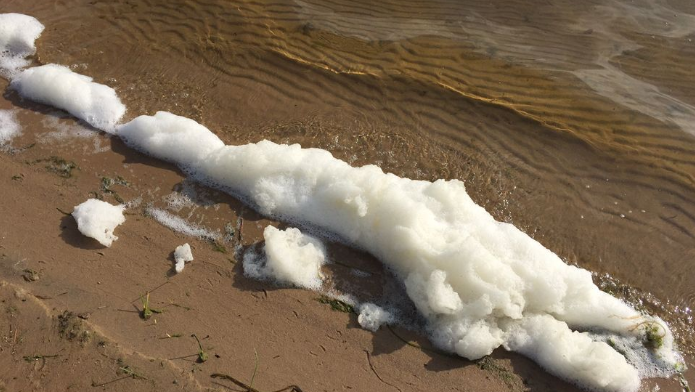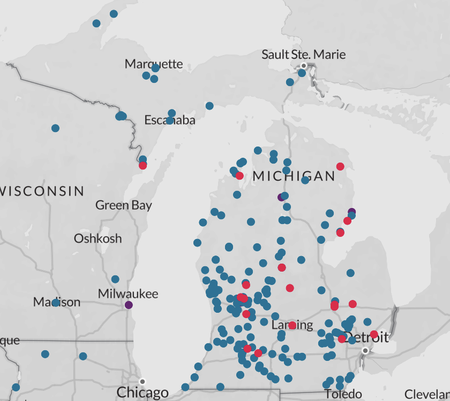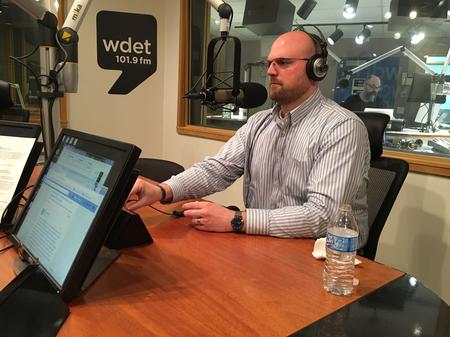Michigan Saw Impacts of Climate Change in 2019, Including Record Great Lakes Water Levels
Flooding caused problems in Detroit and Monroe County. PFAS was also a big story.

The United Nations annual climate talks in Madrid, Spain ended with a general call for greater efforts to tackle climate change, but no agreement on concrete steps to reduce global warming. The meetings capped a year in which the effects of climate change became more apparent around the world and the Great Lakes.
Nick Schroeck is an environmental policy expert and an associate dean at the University of Detroit Mercy School of Law. He blames a lack of leadership.
“There was a lot of infighting about technical details of how to try to meet the goals of the Paris Climate Accord,” Schroeck says. “I think this conference has been largely viewed as a failure, a missed opportunity to get us to those targets where we need to be.”
You Must Love This Planet
Otherwise, how did you get here? 101.9 WDET wants to connect with metro Detroiters who are concerned about climate change and want to take action. Sign-up to be contacted by our editorial team to learn more.
While nations struggle to find common ground on fighting climate change, people are seeing a wide range of problems. Warming oceans, for example, affect the weather.
“Warmer oceans hold more energy, which makes hurricanes and other storms wetter and more powerful,” Schroeck says. He also says events such as heavy rain early in 2019 flooded rural areas, preventing farmers from planting vital crops. They also contributed to record high water levels on the Great Lakes, flooding property on Detroit’s east side and along Lake Erie in Monroe County.
Schroeck says these events, and others, can all be linked to global warming.
“It’s hard to conceptualize a global issue, but we’re seeing the impacts here in Michigan.” — Nick Schroeck.

More from WDET
2019’s Algal Bloom in Lake Erie Could Have Been Worse
Jefferson-Chalmers Residents and Detroit Clash Over Flooding
Here’s How Rising, Warmer Oceans Will Affect You
What Is the Lake Erie Bill of Rights?
Consumers Energy Aims to Close Coal Plants by 2040
Besides climate change, water quality dominated environmental news in 2019. Many stories focused on a group of chemicals known as PFAS (perfluoroalkyl substances) and the potential threat they pose to human health. Schroeck says these compounds aren’t going away.
“These are long strands of carbon, basically,” Schroeck says. “They don’t break down in the environment, but they do build up in our bodies. We’re worried about long-term health effects of ingesting PFAS in drinking water.”
Michigan has been at the forefront of addressing PFAS. The Michigan Department of Environment, Great Lakes and Energy created a PFAS response task force.

Click on the player to hear Nick Schroeck’s conversation with WDET’s Pat Batcheller about environmental stories in 2019, and read a transcript, edited for clarity, below.
Pat Batcheller, 101.9 FM, WDET: What was your takeaway from the climate talks in Madrid?
Nick Schroeck: I think it shows a real lack of global leadership. There was a lot of infighting about technical details of how to try to meet the goals of the Paris Climate Accord. The goals there were to keep global warming below 1.5 degrees Celsius (about 3 degrees Fahrenheit) above pre-industrial levels. To get to that point, a lot of steps have to be taken, mainly reducing greenhouse gases, and countries have not set their targets appropriately to keep us below that level of warming. So I think this conference has been largely viewed as a failure, a missed opportunity to get us to those targets where we need to be. I think that comes down to a lack of leadership, especially by the United States. We’re pulling out of the Paris agreement in 2020. We’re participating in those talks, but more of a silent partner or perhaps helping to run a little interference while those talks progress.

Looking back at the conversations we’ve had in 2019, a couple stand out for me. One is a report that our oceans are rising and getting warmer. The other is record high water levels on the Great Lakes. What threats do these pose?
With the oceans, we have the risk of coastal hazards, such as increased land erosion. In California, they’ve had to move some roads away from coastlines, where valuable property has been washed away. Warmer oceans hold more energy, which makes hurricanes and other storms wetter and more powerful. The Great Lakes have cycles where they go up and down over time. In the last few years, we went from record low water levels to record highs. A lot of that has to do with changing precipitation patterns caused by a warming climate. We’re seeing more rain and more snow in some parts of the Great Lakes basin. More wet weather leads to higher lake levels, which cause flooding and coastal erosion. We’ve seen people having difficulty keeping lake water off their property.
But because the lakes to rise and fall naturally, is there any policy that could actually address that?
We can control, to a degree, some of the depths of the Great Lakes. Lake Ontario is the best example. Through the Welland Canal, officials can actually hold back or release water. But we’re talking about inches, and that’s designed to keep shipping and commerce going through Lake Ontario. The changes we’re seeing are really outside of what we can do. The cyclical nature of lake levels is a challenge, but what we can do is work at trying to reduce the impacts when we do have higher lake levels. That means looking at where the line is where we allow people to build up to the lakes. Where is that flood plain? There are communities all around the region that are looking at restricting development in coastal areas. With higher lake levels, those properties are at risk. They’re potentially a big loss for insurance companies, including those are guaranteed by the government. That means all of us would be paying to keep these properties next to the lakes.
We’ve also talked a lot about the emerging threat of PFAs. Those are chemical compounds that have been used in manufacturing various products over many years. We’ve seen them turn up in our waterways, including the Huron River. Does this seem like a conversation we’re going to be having beyond this year?
Absolutely. These are things that are used to make things like nonstick coating for cookware and waterproof coating for clothing. One of the big sites affected by PFAS in Michigan is the old Hush Puppies shoe factory in western Michigan. They used these materials to waterproof shoes. Those materials were discarded and are leaching into the ground. We’re also seeing contamination near the former Wurtsmith Air Force base in Oscoda. Firefighting foam is another source of these chemicals. These are long strands of carbon, basically. They don’t break down in the environment, but they do build up in our bodies. We’re worried about long-term health effects of ingesting PFAS in drinking water. Michigan is actually working on drinking water standards for PFAS. We’ll be looking for that in 2020. The Environmental Protection Agency is also looking at these chemicals. Right now, there’s a lifetime exposure limit for PFAS, but that’s really not a standard that we use for drinking water or food safety. We hope to see a lot of action addressing those chemicals in 2020.
What environmental story do you think has been overlooked this year?
What we haven’t talked about is just how many of these events are directly related to a warming climate. It’s hard to conceptualize what is a global issue, but we’re seeing the impacts here in Michigan. I don’t think we’re always making the connection between extreme weather events in the spring, high lake levels, more invasive species. Many of those things are related to or driven by climate change. We’re still missing the mark on connecting all of these different environmental stories to climate change.
We’ve seen people demand action on climate change, including Greta Thunberg, the Swedish teenager who became something of an international youth spokesperson on this issue. Closer to home, Toledo voters approved something called the Lake Erie Bill of Rights. This essentially says that the lake, as a living ecosystem, has rights, including the right to be clean. People are paying attention and taking action, but is it enough?
There’s a growing movement called “the rights of nature.” Basically, it treats lakes and other natural objects as people, giving them the same rights that you or I would have to go to court and protect themselves. That was the idea behind the Lake Erie Bill of Rights. Supporters argued that polluters have an out-sized influence on policy affecting Lake Erie, which can’t defend itself. A person would be designated as the advocate for the lake in court, but that’s the idea. We’re seeing this movement grow across the country, but it started internationally as a legal concept to address tough environmental problems that existing environmental laws aren’t prepared to address. For example, when we talk about pollution that makes its way from land into the lake, the Clean Water Act doesn’t address that effectively. The Clean Air Act doesn’t address climate change effectively. We need new ideas, and that’s where things like the youth climate strikers and supporters of the Lake Erie Bill of Rights come up with new, creative solutions to meet these challenges that our existing legal system is not designed to address and has very clumsily attempted to do so. We need new federal legislation, and we need to have people contact their elected officials and demand action.
DTE Energy and Consumers Energy, for example, both announced plans in 2019 to basically eliminate carbon emissions within 20-30 years. Might new laws and regulations hinder efforts in the private sector to address climate change?
We don’t want to disincentivize companies from doing the right thing. We want to encourage them to do the right thing and move toward a future without fossil fuels. I think it’s great they’re moving in that direction, but we’ve known about this problem of climate change for many years. And those same companies actually fought efforts to reduce carbon dioxide emissions over the last 10-20 years. While I think it’s good that they’re coming around, we still need some sort of regulatory floor that will push companies that might not be as responsive as Consumers toward a green energy future. And there aren’t ways for that to be totally voluntary. We need a stick, if you will, to go along with the carrot, which would be things like tax breaks and business incentives. The stick would be regulations to address immediate threats and aggressively reduce greenhouse gas emissions. We know how to do that, it’s just a matter of moving financial resources into that lane. Maybe shareholders don’t quite get the return from our investor-owned utilities. A little bit of that money might need to be invested in renewable energy, or else we’re going to continue to see the deterioration of our climate.
